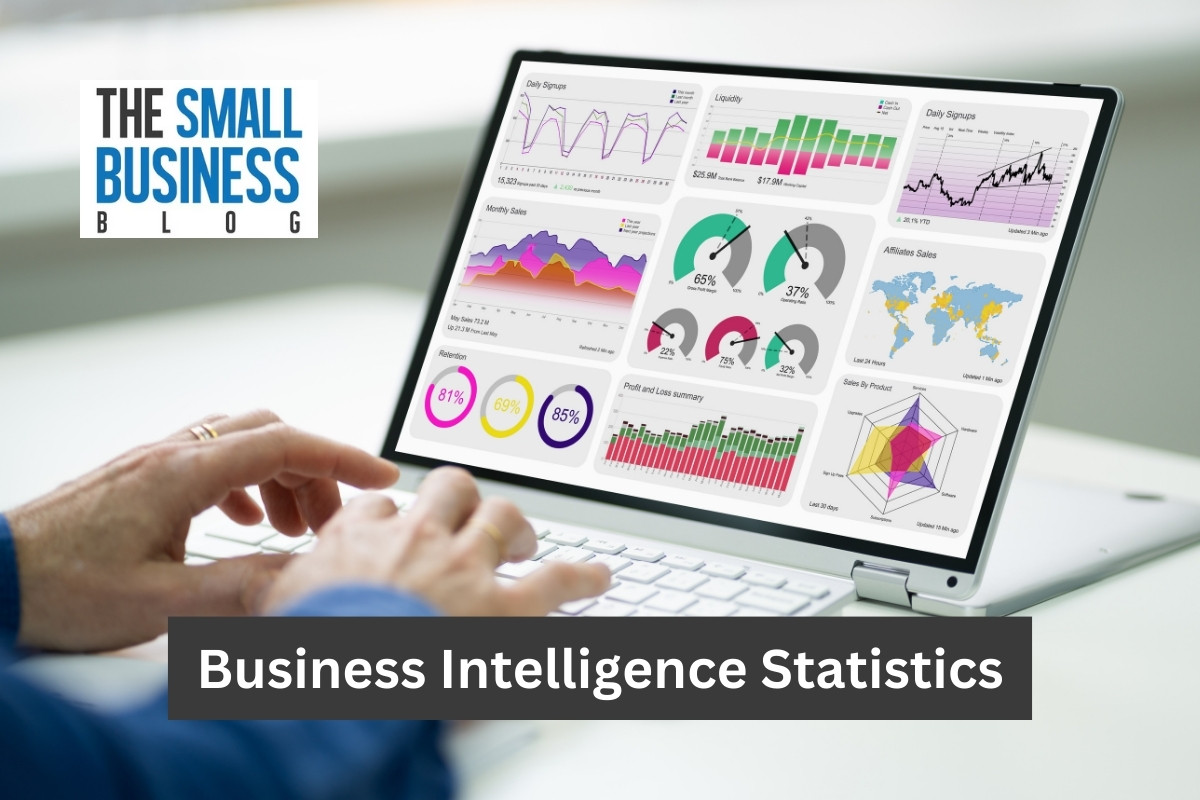Between consumers and the companies they engage with, they generate a long list of business intelligence statistics.
There are many interesting data points that you can take from B2C interactions.
Considering the nature of the topic, available statistics can span decades.
For a different perspective, all of the generated data from consumers and companies is beyond 500 billion iPhone’s worth of storage.
That’s pretty much unfathomable, and the statistics only get more surprising from there.
Business intelligence also considers aspects like data analysis, using it to collect, organize, and present information in an actionable and practical manner.
This article will provide you with a range of business intelligence statistics so you can better understand the importance of business and customer data.
Post Contents
Key Statistics
- Cloud business intelligence (BI) is seen as necessary by 95% of enterprise software vendors
- 49% of small businesses utilize data analytics more than they did before Covid happened
- There was a shortage of a quarter of a million data science professionals in 2020
- Businesses that implement BI solutions see their ROI increase by 127% in about three years
- The global market for BI is expected to reach $43.03 billion by 2028
- The average organization uses around 3.8 BI solutions on average
- Less than 20% of business executives feel they’ve created an effective “data culture” within their organizations
- Between 2021 and 2026, the mobile BI market CAGR is expected to grow by 22.43%
Business Intelligence Statistics on the Surface

Without the help of business intelligence, many corporations wouldn’t know what move to make next.
A lot of it has to do with consumer data and learning how customers operate in every way you can think of.
Tools created for BI have given modern organizations strong insight into their audience and how to grow their business moving forward.
This article will delve into a variety of statistics, but the following section will take more of a general approach to give you a brief overview.
1. The Importance of Data Preparation
More and more businesses are waking up to the importance of business intelligence.
The data you can collect from BI solutions can be extremely valuable.
Over one-third of organizations feel data preparation is highly important.
In addition to that, 27.89% consider data preparation to be a vital component of their overall operations.
Other notable statistics to highlight for this section include:
- 11.22% feel data preparation is only somewhat important
- 1.37% don’t find it to be important at all
- 24.15% find data preparation to be important in general
It’s clear that business owners have varying sentiments about data preparation and BI, but the facts don’t lie.
The reality is that business intelligence is vital, regardless of how much you actually use it.
Keep in mind that business intelligence can be utilized in a long list of ways, and there isn’t a single right way to go about it.
However, the more an organization makes use of BI, the more likely they’ll be able to understand their customer better.
(99Firms)
2. Global BI Adoption Rate
When you take a look at organizations on a global scale, the adoption rate for business intelligence solutions is about 26%.
It’s important to note that this percentage varies greatly, the size of the company being one of them.
For somewhat obvious reasons, larger companies tend to make use of BI more often.
This is likely due to their larger customer base.
Once a company gets big enough, data is one of the main things that helps to keep it going.
It’s hard to keep an eye on every single customer, but data can help simplify information about a customer base to make it easily digestible.
In regard to smaller organizations, they’re less likely to adopt BI solutions.
Companies that have less than 250 employees only come with a 20% adoption rate for business intelligence.
Once again, as these organizations continue to grow, they will more than likely look into more BI solutions.
(99Firms)
3. Average Number of BI Solutions
With the many different BI solutions available, many businesses struggle to find what works best for them.
As mentioned earlier, there isn’t one way to go about utilizing BI data.
On average, corporations that spend time with business intelligence generally make use of 3.8 different solutions.
This makes sense as there are many different data points that make up a customer base.
Additionally, this data is always changing, so it takes consistent monitoring to get an accurate representation of consumers.
A handful of BI solutions is more than enough to get the job done for most organizations.
Some organizations use BI solutions more than others, but the market as a whole is expected to grow quite a bit over the next few years.
(ExplodingTopics)
4. BI Market Growth Estimates (2021-2026)
Business intelligence is only becoming more vital with each passing year.
As it grows in popularity, we’re bound to see the BI market increase in value as well.
Recent statistical data focuses on market growth for business intelligence from 2021 to 2026, and the future is looking pretty healthy for BI.
Industry experts are confident the BI market CAGR will grow by 22.43% by 2026.
It may not seem like a ton, but considering the market as a whole, this percentage isn’t bad by any means.
Of course, this could change drastically by the time 2026 rolls around, and there are many market and economic factors that play into this as well.
Nevertheless, the BI market is on a positive trajectory as more businesses incorporate it into multiple aspects of their internal processes.
(ExplodingTopics)
5. The Benefit of Data-Driven Decisions

There’s enough data to support the benefit behind data-driven decisions in the corporate world.
Corporations that use data to make forward-thinking decisions are better off than those who just wing it as they go.
Businesses can find many different paths to success, but those with executives who make their decisions based on data can potentially find a more effective path.
Organizations are 77% more likely to succeed when they have a CEO who implements data-driven decisions.
This statistic alone proves that business intelligence solutions work.
Moreover, they have proven to be effective for businesses of all types.
Here are a few known benefits that stem from business intelligence:
- Accurate reports on consumers and other businesses
- Flexibility with internal processes
- Improved customer satisfaction
- Discovery of new and emerging markets
- Identify new revenue streams
- Analysis of competitors on multiple fronts
We’re seeing a growing interest in BI solutions in the corporate world as more business owners are waking up to how BI can help.
As more data comes to light about the benefits surrounding BI solutions, more organizations will start to hop on the train.
(EnterpriseAppsToday)
Overview of the Business Intelligence Market
It was briefly mentioned already, but the BI market is expected to grow at a healthy rate over the next few years.
This particular market definitely won’t be seeing a downturn any time soon, as we’re currently going through an increased adoption rate of BI solutions.
However, CAGR is just one part of the puzzle, as there are many different angles to the market that are seeing growth in their own way.
The following statistics will provide an overview of the BI market and many of the subcategories that make up the whole of the industry.
6. An Increasing Need for Analytics & BI Applications
The combined analytics and BI applications market is worth $15.3 billion, all on its own.
By 2026, this market segment is expected to reach $18.5 billion.
Both BI and analytics go hand in hand, each bringing something vital to what business intelligence entails.
In this space, you’ll find a long list of vendors that create products and services to satisfy the market’s needs.
Among the many that are out there, Salesforce, SAP, and SAS Institute are seen as leaders in the industry.
Applications go far beyond what smartphones can offer, and data will always be an extremely valuable asset to any growing business.
When it comes to the analytics side of things, you can break it down into many subtypes, such as predictive and embedded analytics.
(ExplodingTopics)
7. Embedded Analytics on Track for Substantial Revenue
This entails the integration of data into software applications.
Embedded analytics focuses on employees, customers, and any end-users to help generate various data points in business intelligence.
By the end of 2023, the embedded analytics market could be worth over $60 billion.
This specific category brings in more money than many other submarkets in BI.
It’s also growing at a surprising rate, as it was only worth $25 billion back in 2016.
There’s an increasing interest and need in embedded analytics and business intelligence as a whole.
We’re seeing the market grow in real time as more professionals wake up to the importance of BI solutions for their organizations.
(AlliedMarketResearch)
8. What About Predictive Analytics?
Although predictive analytics doesn’t bring in as much money, it’s equally important to the whole of the BI process.
This type of analytics considers past and present data to help with predictive modeling.
Businesses can use this information to predict future trends or changes in the market in many different ways.
It’s expected that by 2026, the predictive analytics market will expand to $22.1 billion in revenue.
The market will also grow at a 24.5% CAGR from now through 2026.
Whereas predictive analytics may not be a necessity for every business, it can be extremely helpful, no matter what stage you’re in.
Being prepared as a business owner is crucial, and predictive analytics can be a helping hand in this regard.
(ExplodingTopics)
9. Who Leads the BI Market?
As with any business trend that finds its way across the world, there are always a few developed nations who lead the way.
Looking at data from 2022, North America was leading the BI market, accounting for a market share of 30.9% at the time.
If you look into the future, there’s always the chance that other developed nations surpass North America, but this may be unlikely.
Nevertheless, business intelligence naturally drives competition, as the data it generates can give a company a leg up over another.
Here are the BI adoption rates for other nations throughout the world:
- Singapore = 93%
- China = 79%
- USA = 66%
- Brazil = 66%
- Germany = 54%
- South Africa = 33%
Although North America is leading in market share, this doesn’t mean other nations aren’t on top of trending developments in business intelligence.
One benefit of BI that isn’t often recognized is the amount of unused data that BI solutions can make use of.
(EnterpriseAppsToday)
10. A Glimpse at Data on a Global Scale

There are many different types of data; some are helpful, while others can be quite harmful.
Considering the amount of data companies produce, it makes you wonder how it’s all being used.
The reality is that a majority of generated data by organizations goes unused, around 70%, to be more precise.
Through various business intelligence solutions, more of this data can be used for good.
Whether it’s improving the customer experience or driving business growth, there’s more than enough incentive to utilize BI solutions.
I’m sure we all agree that there are some aspects of data that should never be used.
In regard to BI, data is used to make improvements in as many ways as possible.
Part of why so much data goes unused is because most organizations don’t have processes in place to manage it or make use of it.
This is where BI solutions come in to save the day.
(EnterpriseAppsToday)
Careers and Challenges in Business Intelligence
While many organizations are eager to make use of BI throughout their operations, there are bound to be a few challenges along the way.
Some are specific to unique circumstances, and some are industry-wide that everyone has to deal with.
No matter which way you look at it, the BI market isn’t perfect, and it’ll need some fine-tuning before it really hits the ground running across the world.
The following statistics will highlight key points related to challenges and careers within the business intelligence industry.
11. Data Volume is Increasing at a Rapid Rate
For those who aren’t so technical, data volume may not be a primary concern, but it is for those who work in the industry.
Between 2020 and 2022, the volume of enterprise data in the world increased from one petabyte to 2.01 petabytes.
This is a significant jump in a short amount of time, and the BI market is scrambling to be able to handle it all and scale.
For reference, one petabyte is 1,000 terabytes.
That’s a massive amount of data, which leads to the next question: where is all of this data being stored exactly?
We can break this down into four main areas.
| Amount of Data | Type of Storage |
| 570 terabytes | Internally managed data centers |
| 498 terabytes | Cloud repositories |
| 407 terabytes | Third-party data centers |
| 390 terabytes | Edge and remote locations |
Each of these methods of data storage has a long road ahead of them.
Internally managed data centers have been the norm for decades.
However, in recent years, much of the corporate world is shifting toward cloud technology as a replacement for a number of reasons.
The primary incentives of cloud technology are time, cost, and space efficiency.
(Statista)
12. Out with the Old and in with the New
Another factor that’s affecting the adoption rate of modern business intelligence is the removal of old, outdated, ineffective processes.
This is easier said than done, as many businesses aren’t sure of what works and what doesn’t.
Trial and error is common in the business world, but you want to keep it as minimal as possible so you don’t hinder growth.
What’s more is that only 27% of business leaders are confident they can translate business data into something actionable.
Not only are we seeing a learning curve in business intelligence, but many business owners simply don’t even know where to start.
This is bound to happen for a while until modern BI processes become the norm in the corporate world.
(ExplodingTopics)
13. Self Awareness Can Take You Far
Organizations that are aware of the benefits of BI have shown to be more successful in more ways than one.
Roughly 20% of executives are confident they’ve created a data-driven culture within their organization.
This means they’re aware of how they use data to move business objectives in the right direction.
That also means that the other 80% don’t consider data to be a core component of their daily business processes.
Below are a few other stats on this topic that give you some insight into how executives are navigating BI solutions right now.
- 56.5% are using data to fuel business innovation
- 47.4% are competitive with their use of data and analytics
- 39.7% manage data as an individual business asset
- 26.5% of executives on a C-level are confident they’ve created an organization that’s driven by data
To be honest, both customers and organizations will benefit by making decisions based on data.
In many cases, corporate decisions based on emotion or gut feeling can take a wrong turn quickly.
There’s no perfect right or wrong approach in business, but using data can ensure you minimize mistakes along the way.
(ExplodingTopics)
14. A Shortage in Data Scientists
To see innovation in BI, we need dedicated professionals moving the industry forward.
Unfortunately, the market is seeing a shortage of data scientists, even though they’re in high demand.
At this time, there are three times as many job openings as there are searches for positions as a data scientist.
Part of this comes down to awareness of the industry.
The concept of BI isn’t understood by most people.
Once it becomes more common knowledge, we’re bound to see more interest in the workforce.
In the meantime, this shortage will affect processes within the industry.
Not so much that it won’t be able to grow, but organizations in this market are having a hard time finding new hires.
BI can pay pretty well, depending on the area of expertise, and it’s a growing area of opportunity for young graduates interested in data, business, and tech.
(ExplodingTopics)
15. Business Intelligence Analyst Salary

You might be wondering if a path as a BI analyst would be a decent career option.
Considering the projected growth of the industry and the need for BI and data moving forward, there will be an increasing need for BI analysts.
With the shortage of data scientists, now is a great time to get involved in the industry.
The average yearly income for an analyst in BI is around $71,758, but this is guaranteed to vary depending on where you live and several other factors.
This number is taken from PayScale data and considers 3,904 different job profiles.
A range you can expect in this profession is $53,000 and $97,000.
With plenty of room for growth and a long-term need for the market, there should be decent job security within this market.
Another interesting stat to point out is that BI analysts have an average job satisfaction rate of 3.8 out of 5.
When you compare that with many other common professions, it’s a lot higher than many other data and tech jobs out there.
It’s an industry that’s on a bumpy road but headed in the right direction for exponential success.
(Payscale)
Conclusion
The world is currently going through a decent learning curve with business intelligence.
Some executives are 100% on top of the matter, while others are just now coming around to the definition of BI.
It has been proven on multiple fronts that BI can be extremely useful, and it’s time organizations catch wind of it early on.
This article provided a variety of business intelligence statistics to shine a light on the importance of business and consumer data in our modern world.






























